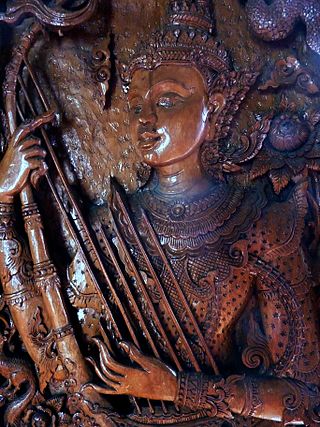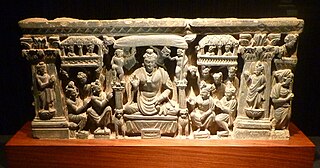Related Research Articles
Nirvana is a concept in the Indian religions of Buddhism, Hinduism, Jainism, and Sikhism that refers to the extinguishing of the passions which is the ultimate state of salvational release and the liberation from duḥkha ('suffering') and saṃsāra, the cycle of birth and rebirth.

Indra is the king of the devas and Svarga in Hinduism. He is associated with the sky, lightning, weather, thunder, storms, rains, river flows, and war.

A gandharva is a member of a class of celestial beings in Indian religions, such as Hinduism, Buddhism, and Jainism, whose males are divine performers such as musicians and singers, and the females are divine dancers. In Hinduism, they are regarded to be the celestial demigods who serve as the musicians of the devas.

Avatar is a concept within Hinduism that in Sanskrit literally means 'descent'. It signifies the material appearance or incarnation of a powerful deity, or spirit on Earth. The relative verb to "alight, to make one's appearance" is sometimes used to refer to any guru or revered human being.
Nirṛti sometimes spelled Nirruti or Nirriti, is a Hindu deity, personifying death, decay, and sorrow. In early Hindu scriptures, Nirṛti is a goddess who is lives in the kingdom of the dead. In later Hinduism, Nirṛti and Nirṛta is also a male god, who is regarded as a dikapala of the southwest.

The historical Vedic religion, also called Vedicism or Vedism, and sometimes ancient Hinduism or Vedic Hinduism, constituted the religious ideas and practices prevalent amongst some of the Indo-Aryan peoples of the northwest Indian subcontinent during the Vedic period. These ideas and practices are found in the Vedic texts, and some Vedic rituals are still practiced today. The Vedic religion is one of the major traditions which shaped modern Hinduism, though present-day Hinduism is significantly different from the historical Vedic religion.
The visvedevas refers to the designation used to address the entirety of the various deities featured in the Vedas. It also refers to a specific classification of deities in the Puranas. The visvedevas are sometimes regarded as the most comprehensive gathering of the gods, a classification in which no deity is stated to be omitted.
Āstika and Nāstika are concepts that have been used to classify the schools of Indian philosophy by modern scholars, as well as some Hindu, Buddhist and Jain texts. The various definitions for āstika and nāstika philosophies have been disputed since ancient times, and there is no consensus. One standard distinction, as within ancient- and medieval-era Sanskrit philosophical literature, is that āstika schools accept the Vedas, the ancient texts of India, as fundamentally authoritative, while the nāstika schools do not. However, a separate way of distinguishing the two terms has evolved in current Indian languages like Telugu, Hindi and Bengali, wherein āstika and its derivatives usually mean 'theist', and nāstika and its derivatives denote 'atheism'. Still, philosophical tradition maintains the earlier distinction, for example, in identifying the school of Sāṃkhya, which is non-theistic, as āstika (Veda-affirming) philosophy, though "God" is often used as an epithet for consciousness (purusha) within its doctrine. Similarly, though Buddhism is considered to be nāstika, Gautama Buddha is considered an avatar of the god Vishnu in some Hindu denominations. Due to its acceptance of the Vedas, āstika philosophy, in the original sense, is often equivalent to Hindu philosophy: philosophy that developed alongside the Hindu religion.

The Smartatradition, also called Smartism, is a movement in Hinduism that developed and expanded with the Puranas genre of literature. It reflects a synthesis of four philosophical strands, namely Uttara Mīmāṃsā, Advaita, Yoga, and theism. The Smarta tradition rejects theistic sectarianism, and is notable for the domestic worship of five shrines with five deities, all treated as equal – Ganesha, Shiva, Shakti, Vishnu and Surya. The Smarta tradition contrasted with the older Shrauta tradition, which was based on elaborate rituals and rites. There has been a considerable overlap in the ideas and practices of the Smarta tradition with other significant historic movements within Hinduism, namely Shaivism, Brahmanism, Vaishnavism, and Shaktism.

Tuṣita (Sanskrit) or Tusita (Pāli) is one of the six deva-worlds of the Desire Realm (Kāmadhātu), located between the Yāma heaven and the Nirmāṇarati heaven. Like the other heavens, Tuṣita is said to be reachable through meditation. It is the heaven where the Bodhisattva Śvetaketu resided before being reborn on Earth as Gautama, the historical Buddha; it is, likewise, the heaven where the Bodhisattva Nātha ("Protector") currently resides, who will later be born as the next Buddha, Maitreya.

In Indian religions, a homa, also known as havan, is a fire ritual performed on special occasions. In Hinduism, by a Hindu priest usually for a homeowner. The grihasth keeps different kinds of fire including one to cook food, heat a home, among other uses; therefore, a Yajna offering is made directly into the fire. A homa is sometimes called a "sacrifice ritual" because the fire destroys the offering, but a homa is more accurately a "votive ritual". The fire is the agent, and the offerings include those that are material and symbolic such as grains, ghee, milk, incense, and seeds.

Brahmā is a leading God (deva) and heavenly king in Buddhism. He is considered as a protector of teachings (dharmapala), and he is never depicted in early Buddhist texts as a creator god. In Buddhist tradition, it was the deity Brahma Sahampati who appeared before the Buddha and invited him to teach, once the Buddha attained enlightenment.

The Buddha is considered the ninth avatar among the ten major avatars of the god Vishnu, according to the Vaishnava tradition of Hinduism.

Buddhism and Hinduism have common origins in the culture of Ancient India. Buddhism arose in the Gangetic plains of Eastern India in the 5th century BCE during the Second Urbanisation. Hinduism developed as a fusion or synthesis of practices and ideas from the ancient Vedic religion and elements and deities from other local Indian traditions.

Dhvaja is the Sanskrit term for a banner or a flag. Flags are featured in the iconography, mythology, and architecture of Indian religions such as Buddhism, Hinduism, and Jainism. They are one of the ashtamangala, the eight auspicious emblems of these religions.

The Tridevi are a trinity of supreme divinity in Hinduism, joining a triad of eminent goddesses either as a feminine version of the Trimurti, or as consorts of a masculine Trimurti, depending on the denomination. This triad is typically personified by the Hindu goddesses Saraswati, Lakshmi, and Parvati. In Shaktism, these triune goddesses are the manifestations of Mula-Prakriti or Mahadevi.

Agni is the Hindu god of fire. and the guardian deity of the southeast direction, he is typically found in southeast corners of Hindu temples. In the classical cosmology of Hinduism, fire (Agni) is one of the five inert impermanent elements (Pañcabhūtá) along with sky (Ākāśa), water (Apas), air (Vāyu) and earth (Pṛthvī), the five combining to form the empirically perceived material existence (Prakṛti).
A bījamantra, or a bījākṣara ("seed-syllable"), is a monosyllabic mantra believed to contain the essence of a given deity. They are found in Tantric Hinduism and in Esoteric Buddhism.
The maharajikas refers to a class of minor deities in Hinduism, numbering 220 or 236 members.
The sadhyas refers to a class of minor deities in Hinduism. According to the Puranas, they are the sons of Dharma and Sadhya, a daughter of Daksha. Numbering either twelve or seventeen according to various texts, the sadhyas are described to be the embodiments of the rituals and hymns of the Vedas. They are stated to reside with the devas, or dwell in the region between heaven and earth.
References
- ↑ Werner, Karel (2005-08-11). A Popular Dictionary of Hinduism. Routledge. p. 29. ISBN 978-1-135-79752-2.
- ↑ Dalal, Roshen (2014-04-18). Hinduism: An Alphabetical Guide. Penguin UK. p. 103. ISBN 978-81-8475-277-9.
- ↑ Danielou, Alain (2017-01-01). The Myths and Gods of India: The Classic Work on Hindu Polytheism. Motilal Banarsidass. p. 303. ISBN 978-81-208-3638-9.
- ↑ Walker, Benjamin (2019-04-09). Hindu World: An Encyclopedic Survey of Hinduism. In Two Volumes. Volume I A-L. Routledge. p. 397. ISBN 978-0-429-62465-0.